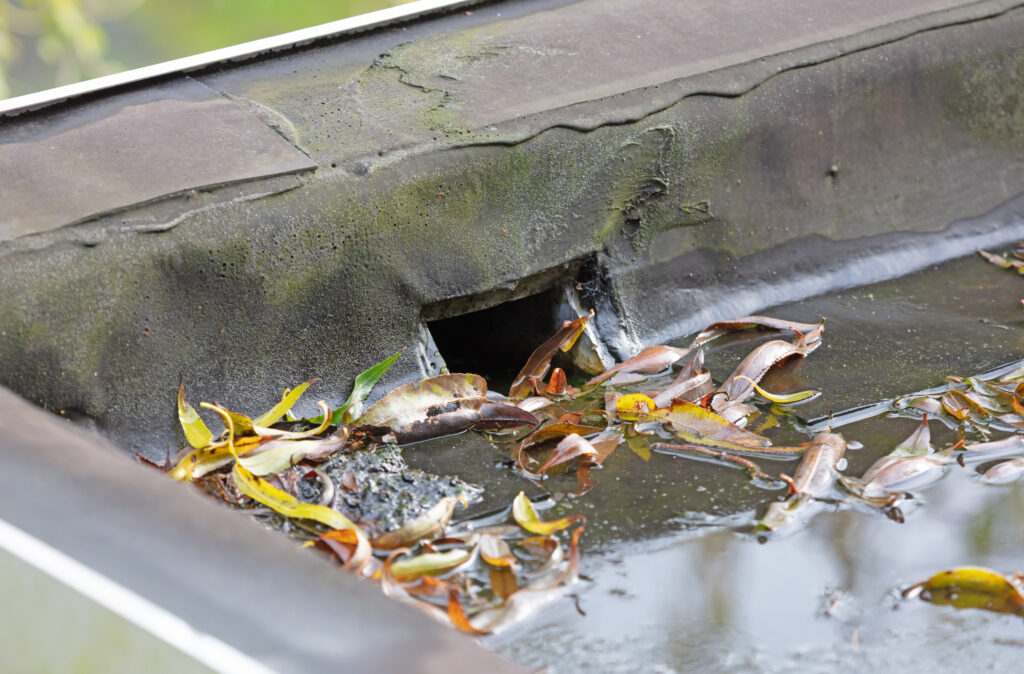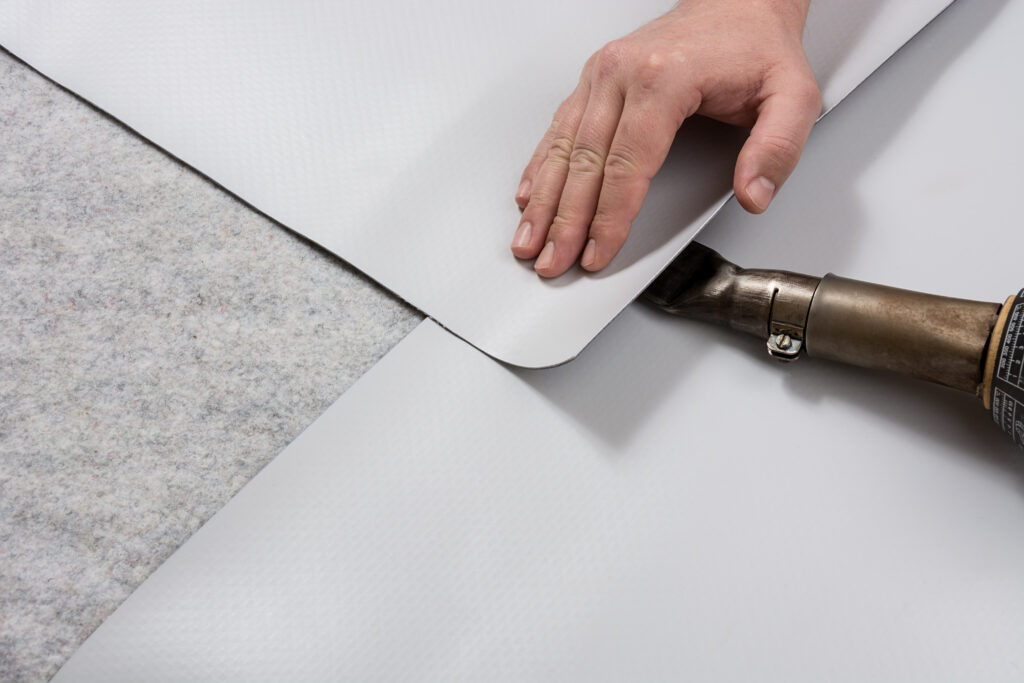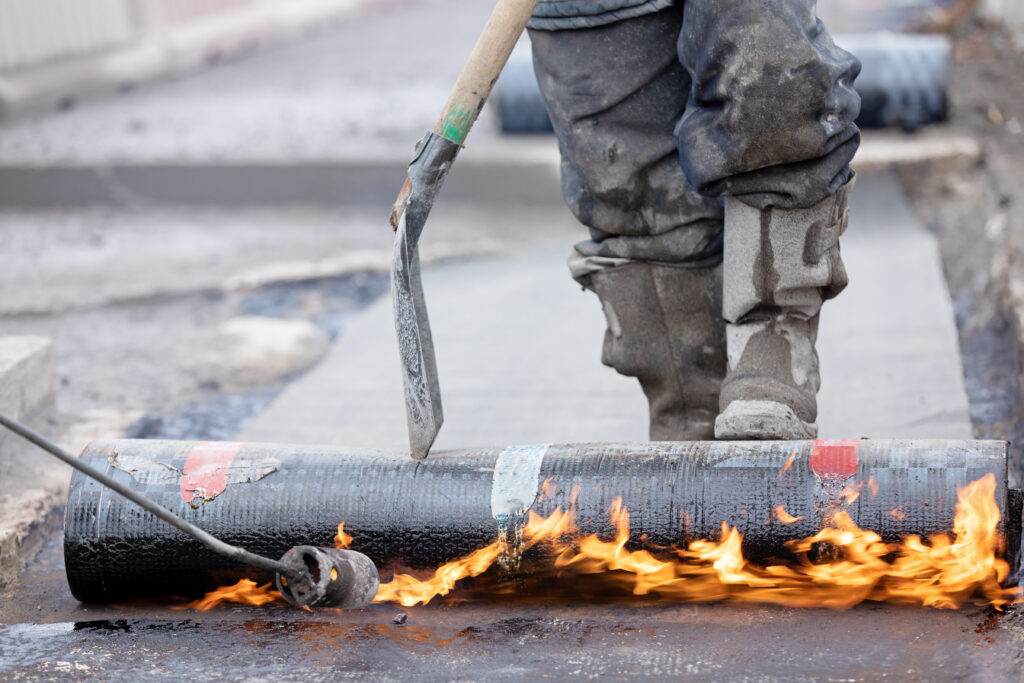Is your living room turning into a swimming pool because of your roof? Leaky roofs are common in all households, and dealing with them can be an uphill battle. If you have a flat roof that keeps showering you with water droplets, today is your lucky day!
We’ve prepared a guide about flat roof leak repair, including what causes it, how to fix it, and what materials you or your contractor will need. If the problem is getting out of hand and you need professional help, get in touch with us now!
What Causes a Leaky Flat Roof?
Flat roof leaks can happen because of damage or old age. Here’s a list of reasons you have water dripping inside your house!
Poor Drainage
Poor drainage is more common on flat roofs than on sloped roofs because gravity doesn’t help slide water over the edge. It’s caused by many factors, most commonly clogged gutters, and sagging decks. When water isn’t properly drained, it sits on top of your roof and adds unnecessary pressure on its materials, which can cause damage and eventually leaks.
Damaged or Improperly Installed Roof Flashing
Flashing is a thin layer of material installed on roofs to steer water away from points where it can collect, like valleys and chimneys. If damaged or improperly installed, it can allow water to seep into your roof materials and through the walls.
Old Age
Roofs are exposed to the natural elements 24/7, which can cause erosion and corrosion. When the materials are far too damaged, they’ll have a lot of cracks where water can seep into your house. If your roof is older than 15-20 years, chances are that it’s eroded beyond fixing and needs replacing.
How to Fix a Leaky Flat Roof
Flat roof repairs are best done by professional contractors to ensure a seamless fix. However, if you want to get familiar with the process of fixing a leaking flat roof, here are the steps to do so!
1. Find the Source of the Leak
The source of the leak doesn’t necessarily have to be where you first see water leaking inside your house. Water moves through roof materials and walls, so it might have traveled a long distance before it ended up in your room.
To find the leak source, you should first look from inside your attic and then trace it back to the outside. If you can’t find it inside, go on top of the roof but practice caution because damaged roofs can be dangerous to stand on. If the roof is slippery or icy, contact a professional.
The places you should focus on are any broken or missing shingles, rusty nails, and damaged flashing.
2. Clean Debris and Dry the Damaged Area

After you locate the source of the leak, you should get a ladder and climb to the top of the roof. First, clean any debris you find over the damaged area so that you can see it clearly. You might find tree branches, accumulated dirt, fallen objects, and more.
Then, dry the area thoroughly, making sure no more moisture seeps through. This step is critical because if you fix your roof while still wet, you’ll trap water beneath the newly added materials, risking water damage and mold growth.
3. Remove the Damaged Area and Apply a Layer of Roofing Cement
Once you see the damaged spot clearly, be it a blister or a crack, cut around it using a utility knife till the roof’s membrane rests flat. Make sure not to go lower than the damaged area to avoid cutting too deep through your roofing material. Then, apply a thick layer of roofing cement on top of the area you cut and till 6 inches around.
4. Add the Patching Materials
Roofs come in many materials, and each one requires a specific patching material for repair. For instance, a TPO roof will only work with TPO patches, while EPDM rubber roofs require EPDM patches. If you don’t know what material is suitable for patching your roof, contact a professional roofing contractor.
Place a layer of your patching material over the newly applied cement. Press over it with the trowel to make sure it sticks properly, then apply another layer of cement over it. Repeat these two steps to enhance the roof’s resistance to water, then add a layer of gravel on top to protect the damaged area from sun damage.
5 Flat Roof Repair Materials You Might Come Across
If you DIY your way through your flat roof repair, you’ll come across many patching materials you might need. Here’s a brief roundup of them so that you can familiarize yourself with the terms.
TPO (Thermoplastic Polyolefin)

Thermoplastic polyolefin, also known as TPO, is a white single-ply membrane designed to reflect heat instead of absorbing it, causing a cooling effect inside properties. It’s made from a durable polymer that can last for years without needing a roof replacement.
EPDM (Ethylene Propylene Diene Terpolymer)
EPDM is a type of rubber membrane made from ethylene and propylene. Its main selling point is its unprecedented durability, and it’s one of the easiest materials to deal with in a flat roof repair, thanks to its flexibility and easy adhesiveness.
PVC (Polyvinyl Chloride)
PVC is a white single-ply roof membrane famous for its resistance to fire and water damage. It’s reinforced with a layer of polyester between two PVC layers to improve its durability and longevity. If your entire roof is made from PVC, you’ll need PVC patches to fix any cracks or blisters.
Modified Bitumen

Modified bitumen is a roofing material made from a combination of asphalt, polymerized plastic or rubber, and fiberglass. It’s extremely durable and waterproof, but fixing it isn’t as easy as the other flat roofing materials. You’ll need to apply heat using an open-flame propane torch to patch it, considering it’s a torch-down roofing. That’s why we always recommend leaving it to the professionals.
Tar and Gravel
Tar and gravel roof membranes are made from multiple layers of asphalt and fiberglass, rendering them long-lasting and durable. They’re one of the most resistant materials to natural elements, like rain and direct sunlight. Patching tar and gravel roofs include applying tar and asphalt-saturated fabric to the affected area and then covering it with gravel.
Flat Roof Repair Costs: How Much Will You Pay?
The average flat roof repair cost depends on what material you’ll use, as some are more expensive than others. For instance, PVC costs about $5-12 per square foot, while modified bitumen averages $6 per square foot. Also, the prices might change according to the labor costs in your city and how extensive the damage is on your roof.
If it’s too extensive, your contractor might suggest an entire flat roof replacement, which can cost you up to $10,000 or more.
How Do I Know If My Roof Needs Replacement?
If you want to know whether you need a mere flat roof maintenance or an entire replacement, you should look at the general condition of your roof. Is the damaged area small enough to be covered? Are there multiple blisters and cracks covering your roof, or just one?
Also, you should try to figure out the cause of the damage. If it was caused by harsh weather conditions or an unfortunate accident, then chances are the rest of your roof is fine. However, if there’s no definite reason for the leaking, you’re most probably dealing with an old roof that needs replacement.
Finally, you should see if the leak has been there too long that it caused mold growth or rot. These two problems are major and might call for full roof replacement.
All in all, it’s better to consult a professional roofer about your flat roof repair options. You don’t want to replace your entire roof and then find out it wasn’t necessary; believe us!
Frequently Asked Questions
How Long Do Flat Roofs Last?
Flat roofs last an average of 25 years if installed and maintained properly. Regular maintenance and cleaning can also extend your roof’s life further. However, factors like harsh weather conditions and mold growth can drastically lower this number.
Leaks often happen after 10-15 years. If they happen earlier than that, you might have an improperly installed roof.
Are Synthetic or Natural Roofs More Prone to Water Damage?
Synthetic roofs are more resistant to water damage than natural roofs because they’re built to repel moisture. Meanwhile, natural materials, like wood, absorb water and rot easily.
To Wrap Up
Dealing with a leaky roof comes with the package of owning a house. It’s one of the most common roofing problems, especially on flat roofs. Luckily, most of the time, it can be fixed by patching the damaged area. It won’t cost you much if the damaged area is small, but it’s a job better left to professionals to avoid damaging your roofing materials further.
If you want to repair your roof or get a general inspection, check our service areas and call us now!
